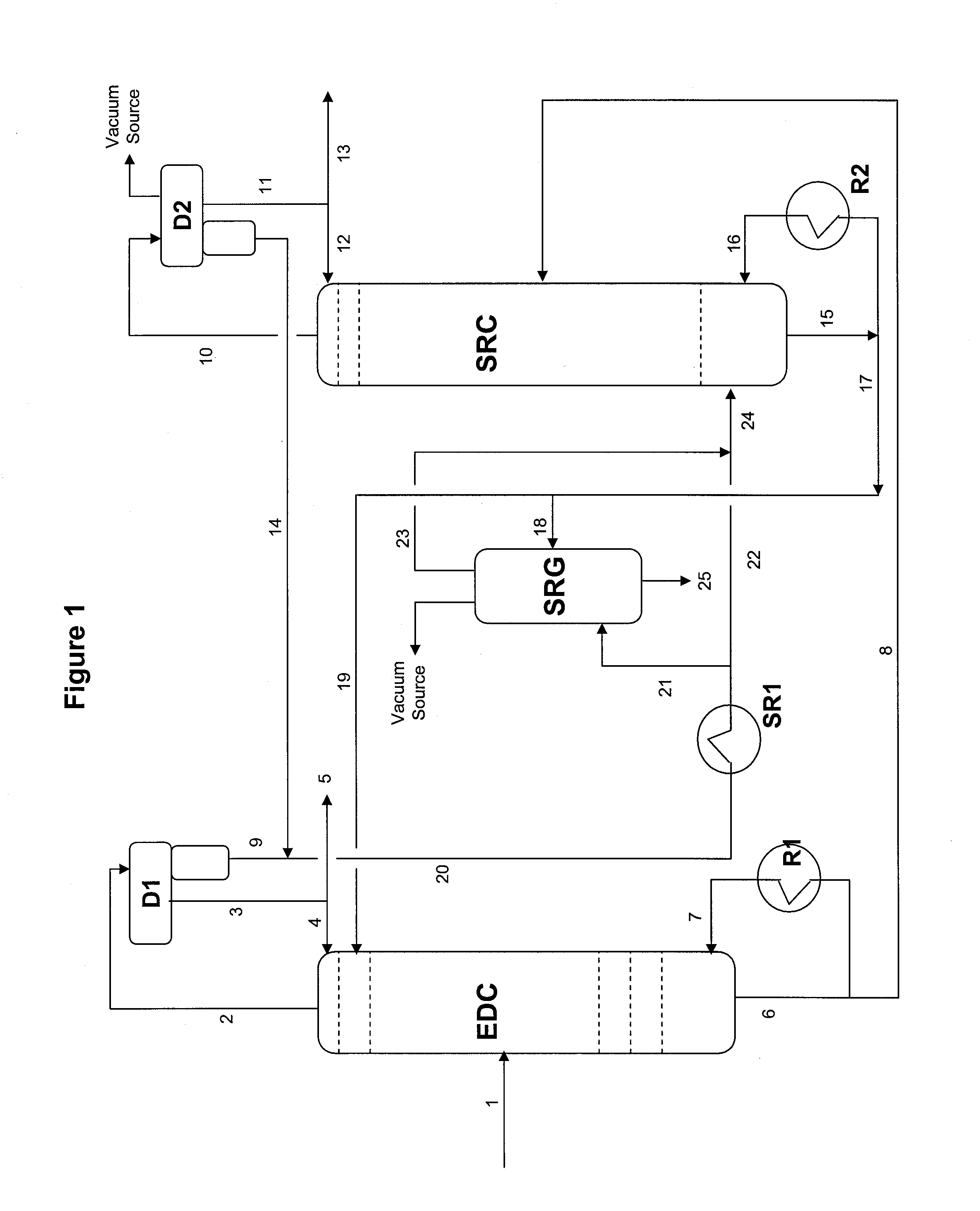Extractive distillation process for recovering aromatics from petroleum streams
a petroleum stream and distillation process technology, applied in the direction of hydrocarbon distillation, azeotropic/extractive distillation, separation processes, etc., can solve the problems of not being able to satisfactorily process unable to recover btx aromatics from the full boiling-range feedstock, and unable to achieve the full boiling-range aromatic feedstock. achieve the effect of maximizing the recovery of benzen
- Summary
- Abstract
- Description
- Claims
- Application Information
AI Technical Summary
Problems solved by technology
Method used
Image
Examples
example 1
[0105]An amount of approximately 6 grams of cumene (presenting C9 aromatic hydrocarbons) was added to 100 grams of sulfolane to make a homogeneous solution. To simulate a one-stage liquid-liquid extraction, 100 grams of the combined solution was thoroughly mixed with different amounts of deionized water in a separatory funnel at ambient temperature. The cumene and aqueous solvent phases were allowed to separate. The amounts of cumene phase measured for different runs are presented in Table 1.
TABLE 1Cumene Phase RunsSolvent Mixture: 100 grams containing 5.66 wt % cumeneWater Add (grams)Cumene Phase (grams)Cumene Recovery (%)200.7413.16403.7466.02804.7684.011005.1590.931505.2692.872005.2893.35
[0106]Table 1 shows that water extraction is very effective in removing cumene (heavy aromatics) from sulfolane. More than 90% of cumene was extracted from sulfolane (containing as high as 5.66% cumene) under a water-to-sulfolane weight ratio of 1.0 in a one-stage extraction. Extraction performan...
example 2
[0107]An amount of 1.37 grams of decahydronaphthalene (DCHN) (presenting C10 naphthenic hydrocarbons) was added to 100 grams of sulfolane to make a homogeneous solution. The solution was thoroughly mixed with 100 grams of the resulting solution and different amounts of deionized water in a separatory funnel at ambient temperature to allow the DCHN and aqueous solvent phases to separate. The amounts of cumene phase measured for different runs are presented in Table 2.
TABLE 2Cumene Phase RunsSolvent Mixture: 100 grams containing 1.35 wt % DCHNWater Add (grams)DCHN Phase (grams)DCHN Recovery (%)100.312823.17200.637747.24400.895366.32801.005574.481501.011674.932001.097581.30
[0108]Table 2 illustrates that the water extraction according to the present invention is very effective for removing DCHN (heavy naphthenes) from sulfolane. More than 80% of DCHN was extracted from sulfolane (containing as high as 1.35% DCHN) under a water-to-sulfolane weight ratio of 2.0 in one-stage extraction. Ag...
example 3
[0109]An amount of 0.29 grams of n-dodecane (n-C12P) (presenting C12 paraffinic hydrocarbons) was added to 100 grams of sulfolane to make a homogeneous solution. Again, a mix of 100 grams of sulfolane was thoroughly mixed and made of a solution with different amounts of deionized water in a separatory funnel at ambient temperature. The n-C12P and aqueous solvent phases were allowed to separate. The amounts of n-C12P phase measured for different runs are presented in Table 3.
TABLE 3n-C12P Phase RunsSolvent Mixture: 100 grams containing 0.29 wt % n-C12PWater Add (grams)n-C12P Phase (grams)n-C12P Recovery (%)200.094832.69400.148551.21800.217274.901000.273194.171500.273994.45
[0110]Table 3 shows that water extraction is very effective in removing n-C12P (heavy paraffins) from sulfolane. Nearly 95% of n-C12P was extracted from sulfolane (containing 0.29% n-C12P) under a water-to-sulfolane weight ratio of 1.0 in one-stage extraction. Therefore, extraction performance would be substantially...
PUM
| Property | Measurement | Unit |
|---|---|---|
| pressure | aaaaa | aaaaa |
| temperature | aaaaa | aaaaa |
| pressure | aaaaa | aaaaa |
Abstract
Description
Claims
Application Information
 Login to View More
Login to View More - R&D
- Intellectual Property
- Life Sciences
- Materials
- Tech Scout
- Unparalleled Data Quality
- Higher Quality Content
- 60% Fewer Hallucinations
Browse by: Latest US Patents, China's latest patents, Technical Efficacy Thesaurus, Application Domain, Technology Topic, Popular Technical Reports.
© 2025 PatSnap. All rights reserved.Legal|Privacy policy|Modern Slavery Act Transparency Statement|Sitemap|About US| Contact US: help@patsnap.com



